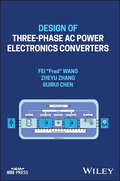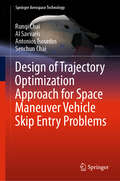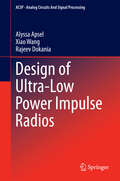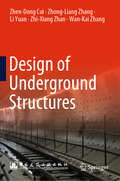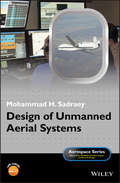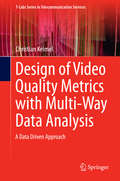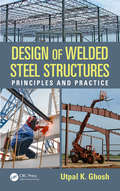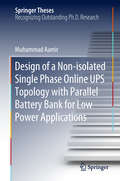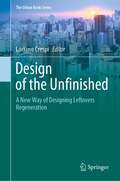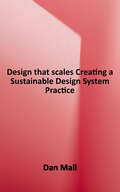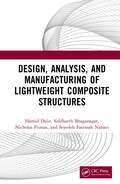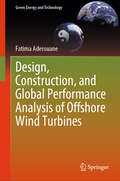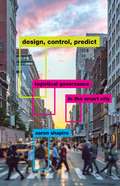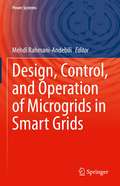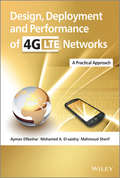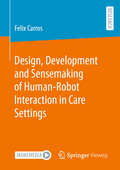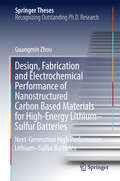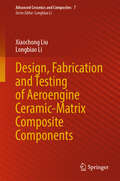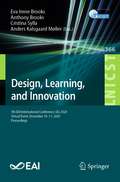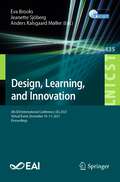- Table View
- List View
Design of Thermal Oxidation Systems for Volatile Organic Compounds
by David A LewandowskiControlling the emission of volatile organic compounds (VOC) became a very prominent environmental issue with the passage of the 1990 Clean Air Act Amendments, and will continue to be an environmental priority through the next decade. No single technology has played as important a role in the control of VOC emissions as thermal oxidation. It has the ability to destroy VOCs in a one-step process that produces innocuous by-products.Design of Thermal Oxidation Systems for Volatile Organic Compounds provides all the information needed for developing a thermal oxidation design in a single reference. It covers design, operation, and maintenance as well as the principles behind the classification of volatile organic compounds as hazardous waste. The author explores the primary purpose of thermal oxidizers and discusses their limitations.The book provides:practical, complete, and concise thermal oxidizer design principlesan outline of state-of-the-art design principlesa practical rather than theoretical approachreal industrial examples in each chapterWith the new regulations that affect VOC emissions, engineers from such diverse fields as oil refining, chemical distillation and separation processes, and pharmaceutical industries will need to design and implement thermal oxidation systems. Design of Thermal Oxidation Systems for Volatile Organic Compounds provides a reference to the entire design process, from conceptualization to operation and maintenance.
Design of Three-phase AC Power Electronics Converters (IEEE Press)
by Fei "Fred" Wang Zheyu Zhang Ruirui ChenDESIGN OF THREE-PHASE AC POWER ELECTRONICS CONVERTERS Comprehensive resource on design of power electronics converters for three-phase AC applications Design of Three-phase AC Power Electronics Converters contains a systematic discussion of the three-phase AC converter design considering various electrical, thermal, and mechanical subsystems and functions. Focusing on establishing converter components and subsystems models needed for the design, the text demonstrates example designs for these subsystems and for the whole three-phase AC converters considering interactions among subsystems. The design methods apply to different applications and topologies. The text presents the basics of the three-phase AC converter, its design, and the goal and organization of the book, focusing on the characteristics and models important to the converter design for components commonly used in three-phase AC converters. The authors present the design of subsystems, including passive rectifiers, inverters and active rectifiers, electromagnetic interference (EMI) filters, thermal management system, control and auxiliaries, mechanical system, and application considerations, and discuss design optimization, which presents methodology to achieve optimal design results for three-phase AC converters. Specific sample topics covered in Design of Three-phase AC Power Electronics Converters include: Models and characteristics for devices most commonly used in three-phase converters, including conventional Si devices, and emerging SiC and GaN devices Models and selection of various capacitors; characteristics and design of magnetics using different types of magnetic cores, with a focus on inductors Optimal three-phase AC converter design including design and selection of devices, AC line inductors, DC bus capacitors, EMI filters, heatsinks, and control. The design considers both steady-state and transient conditions Load and source impact converter design, such as motors and grid condition impacts For researchers and graduate students in power electronics, along with practicing engineers working in the area of three-phase AC converters, Design of Three-phase AC Power Electronics Converters serves as an essential resource for the subject and may be used as a textbook or industry reference.
Design of Trajectory Optimization Approach for Space Maneuver Vehicle Skip Entry Problems (Springer Aerospace Technology)
by Antonios Tsourdos Runqi Chai Al Savvaris Senchun ChaiThis book explores the design of optimal trajectories for space maneuver vehicles (SMVs) using optimal control-based techniques. It begins with a comprehensive introduction to and overview of three main approaches to trajectory optimization, and subsequently focuses on the design of a novel hybrid optimization strategy that combines an initial guess generator with an improved gradient-based inner optimizer. Further, it highlights the development of multi-objective spacecraft trajectory optimization problems, with a particular focus on multi-objective transcription methods and multi-objective evolutionary algorithms. In its final sections, the book studies spacecraft flight scenarios with noise-perturbed dynamics and probabilistic constraints, and designs and validates new chance-constrained optimal control frameworks. The comprehensive and systematic treatment of practical issues in spacecraft trajectory optimization is one of the book’s major features, making it particularly suited for readers who are seeking practical solutions in spacecraft trajectory optimization. It offers a valuable asset for researchers, engineers, and graduate students in GNC systems, engineering optimization, applied optimal control theory, etc.
Design of Ultra-Low Power Impulse Radios
by Xiao Wang Alyssa Apsel Rajeev DokaniaThis book covers the fundamental principles behind the design of ultra-low power radios and how they can form networks to facilitate a variety of applications within healthcare and environmental monitoring, since they may operate for years off a small battery or even harvest energy from the environment. These radios are distinct from conventional radios in that they must operate with very constrained resources and low overhead. This book provides a thorough discussion of the challenges associated with designing radios with such constrained resources, as well as fundamental design concepts and practical approaches to implementing working designs. Coverage includes integrated circuit design, timing and control considerations, fundamental theory behind low power and time domain operation, and network/communication protocol considerations.
Design of Underground Structures
by Li Yuan Zhen-Dong Cui Zhong-Liang Zhang Zhi-Xiang Zhan Wan-Kai ZhangThis book provides a general review of the literature on underground structures, combined with new specifications, engineering case studies, and numerical simulations based on the authors’ research. It focuses on the basic concepts, theories, and methods of the design of underground structures. After an introduction, it covers various topics, such as elastic foundation beam theory and numerical analysis methods for underground structures, as well as the design of shallow underground structures, diaphragm wall structures, shield tunnel structures, caisson structures, immersed tube structures, and integral tunnel structures. It also includes tables for calculating elastic foundation beam. This book is intended for senior undergraduate and graduate students majoring in urban underground space engineering, building engineering, highway engineering, railway engineering, bridge and tunnel engineering, water conservancy and hydropower engineering.
Design of Unmanned Aerial Systems (Aerospace Series)
by Mohammad H. SadraeyProvides a comprehensive introduction to the design and analysis of unmanned aircraft systems with a systems perspective Written for students and engineers who are new to the field of unmanned aerial vehicle design, this book teaches the many UAV design techniques being used today and demonstrates how to apply aeronautical science concepts to their design. Design of Unmanned Aerial Systems covers the design of UAVs in three sections—vehicle design, autopilot design, and ground systems design—in a way that allows readers to fully comprehend the science behind the subject so that they can then demonstrate creativity in the application of these concepts on their own. It teaches students and engineers all about: UAV classifications, design groups, design requirements, mission planning, conceptual design, detail design, and design procedures. It provides them with in-depth knowledge of ground stations, power systems, propulsion systems, automatic flight control systems, guidance systems, navigation systems, and launch and recovery systems. Students will also learn about payloads, manufacturing considerations, design challenges, flight software, microcontroller, and design examples. In addition, the book places major emphasis on the automatic flight control systems and autopilots. Provides design steps and procedures for each major component Presents several fully solved, step-by-step examples at component level Includes numerous UAV figures/images to emphasize the application of the concepts Describes real stories that stress the significance of safety in UAV design Offers various UAV configurations, geometries, and weight data to demonstrate the real-world applications and examples Covers a variety of design techniques/processes such that the designer has freedom and flexibility to satisfy the design requirements in several ways Features many end-of-chapter problems for readers to practice Design of Unmanned Aerial Systems is an excellent text for courses in the design of unmanned aerial vehicles at both the upper division undergraduate and beginning graduate levels.
Design of Video Quality Metrics with Multi-Way Data Analysis
by Christian KeimelThis book proposes a data-driven methodology using multi-way data analysis for the design of video-quality metrics. It also enables video- quality metrics to be created using arbitrary features. This data- driven design approach not only requires no detailed knowledge of the human visual system, but also allows a proper consideration of the temporal nature of video using a three-way prediction model, corresponding to the three-way structure of video. Using two simple example metrics, the author demonstrates not only that this purely data- driven approach outperforms state-of-the-art video-quality metrics, which are often optimized for specific properties of the human visual system, but also that multi-way data analysis methods outperform the combination of two-way data analysis methods and temporal pooling.
Design of Welded Steel Structures: Principles and Practice
by Utpal K. GhoshDesign of Welded Steel Structures: Principles and Practice provides a solid foundation of theoretical and practical knowledge necessary for the design of welded steel structures. The book begins by explaining the basics of arc welding, describing the salient features of modern arc welding processes as well as the types and characteristics of welded
Design of Wind and Earthquake Resistant Reinforced Concrete Buildings
by Somnath Ghosh Arundeb GuptaDesign of Wind and Earthquake Resistant Reinforced Concrete Buildings explains wind and seismic design issues of RCC buildings in brief and provides design examples based on recommendations of latest IS codes essential for industrial design. Intricate issues of RCC design are discussed which are supplemented by real-life examples. Guidelines are presented for evaluating the acceptability of wind-induced motions of tall buildings. Design methodologies for structures to deform well beyond their elastic limits, which is essential under seismic excitation, have been discussed in detail. Comparative discussion including typical design examples using recent British, Euro and American codes is also included. Features: Explains wind and earthquake resistant design issues, balancing theoretical aspects and design implications, in detail Discusses issues for designing the wind and earthquake resistant RCC structures Provides comprehensive understanding, analysis, design and detailing of the structures Includes a detailed discussion on IS code related to wind and earthquake resistant design and its comparison with Euro, British and American codes Contains architectural drawings and structural drawings along with STAAD Pro input and output files The book is aimed at researchers, professionals, graduate students in wind and earthquake engineering, design of RCC structures, modelling and analysis of structures, civil/infrastructure engineering.
Design of a Non-isolated Single Phase Online UPS Topology with Parallel Battery Bank for Low Power Applications (Springer Theses)
by Muhammad AamirThis book presents a new topology of the non-isolated online uninterruptible power supply (UPS) system consisting of 3 components: bridgeless boost rectifier, battery charger/discharger, and an inverter. The online UPS system is considered to be the most preferable UPS due to its high level of power quality and proven reliability against all types of line disturbances and power outages. The new battery charger/discharger reduces the battery bank voltage, which improves performance and reliability, while a new control method for the inverter regulates the output voltage for both linear and nonlinear loads. The proposed USP system shows an efficiency of 94% during battery mode and 92% during the normal mode of operation.
Design of the Unfinished: A New Way of Designing Leftovers Regeneration (The Urban Book Series)
by Luciano CrespiThe book aims to provide city administrators and planners with a tool to accompany them in experimenting with the regeneration of no longer used parts of the built heritage, called leftovers, by adopting an innovative approach. A new and radically different form of project, with the task of proposing a new aesthetic code and a style of thought aimed at creating shelters for nomads of the third millennium.In the design field, the 21st century will be destined to measure itself against temporariness and precariousness, also in terms of aesthetic practices. Based on this hypothesis, the text identifies the design of the unfinished as the perspective for attributing to the leftovers a character, which is representative of the conditions of the just begun century. Through a transdisciplinary, exhibition-like and reversible approach, the elements of degradation of the existing work are welcomed in the project as a "gift", to be translated into a syntax aimed at giving form and meaning to the internal and external environments, with the inclusion of "additional components".
Design that Scales: Creating a Sustainable Design System Practice
by Dan MallAfter years of building the same interface elements, some designers and developers get wise and try to create reusable, common solutions to help everyone stop reinventing the wheel every time. Most fail. In Design That Scales, design systems expert Dan Mall draws on his extensive experience helping some of the world's most recognizable brands create design practices that are truly sustainable and successful. "Dan's book is a game–changer for our approach to design systems, leading to significant changes at my company, making it a must–read for streamlining anyone’s complex design systems!" —Nadine Sarraj, Product Designer, 365 Retail Markets Who Should Read This Book? People who are building and maintaining design systems, large or small. Designers, engineers, and product managers who are in search of a more efficient way to work. Leaders and executives who want to effect change but aren't sure how to do it. People who have designed web forms and tables, but don't know what’s next. Takeaways - A design system is crucial for any organization managing two or more digital products. Learn how to create, manage, and sustain a successful design system. - See how the ecosystem of a design system works in order to understand the context for success. - Figure out where the people involved in a design system fit and how they can best collaborate. - Learn the metrics for success within a design system and how to measure them. - Determine the best techniques for marketing your design system to stakeholders. - Learn what guidance and relationships are crucial for a design system to succeed. - See the end-of-chapter questions that highlight how to guide your design system to a profitable outcome.
Design with the Desert: Conservation and Sustainable Development
by Richard MalloyTypical development in the American Southwest often resulted in scraping the desert lands of the ancient living landscape, to be replaced with one that is human-made and dependent on a large consumption of energy and natural resources. This transdisciplinary book explores the natural and built environment of this desert region and introduces development tools for shaping its future in a more sustainable way. It offers valuable insights to help promote ecological balance between nature and the built environment in the American Southwest-and in other ecologically fragile regions around the world.
Design, Analysis and Control of Cable-suspended Parallel Robots and Its Applications
by Bin Zi Sen QianThis book provides an essential overview of the authors' work in the field of cable-suspended parallel robots, focusing on innovative design, mechanics, control, development and applications. It presents and analyzes several typical mechanical architectures of cable-suspended parallel robots in practical applications, including the feed cable-suspended structure for super antennae, hybrid-driven-based cable-suspended parallel robots, and cooperative cable parallel manipulators for multiple mobile cranes. It also addresses the fundamental mechanics of cable-suspended parallel robots on the basis of their typical applications, including the kinematics, dynamics and trajectory tracking control of the feed cable-suspended structure for super antennae. In addition it proposes a novel hybrid-driven-based cable-suspended parallel robot that uses integrated mechanism design methods to improve the performance of traditional cable-suspended parallel robots. A comparative study on error and performance indices of hybrid-driven based and traditional cable-suspended parallel robots rounds out the coverage. This book addresses the needs of researchers, engineers and post-graduates in the field of cable-suspended parallel robots and related areas.
Design, Analysis, and Manufacturing of Lightweight Composite Structures
by Hamid Dalir Siddharth Bhaganagar Nicholas Frimas Seyedeh Fatemah NabaviDesign, Analysis, and Manufacturing of Lightweight Composite Structures provides a thorough guide to composite materials and their applications, suitable for students of all levels, as well as those in the industry. Covering established theory as well as cutting-edge developments in the field, this book is an essential companion to anyone interested in composite materials.Discussing the mechanical properties of advanced composites and their materials, this book describes testing and evaluation, focusing on sustainability in manufacturing. Looking at how composite materials can form structural components, this book is centered around how to design and analyze these materials as appropriate to different applications. It discusses micromechanics, stiffness matrices, and numerical calculations using MATLABR, Excel, and Python. It also covers failure, applied forces, strain, and stress, alongside finite element analysis of composites.This book is suitable for students and researchers in the field of composites, mechanical design, micromechanics, mechanics of solids, and material science. It also has relevance to the automotive industry.
Design, Construction, and Global Performance Analysis of Offshore Wind Turbines (Green Energy and Technology)
by Fatima AderouaneThis extensive and expansive book focuses on three core areas of detail: the design, construction, and classification criteria for offshore bottom-load wind turbines; offshore floating-load wind turbines; and the global performance and integrated load analysis of offshore wind turbines. The book explains the rules and regulations (as they currently exist) around the design and building of offshore wind turbines and then analyzes their performance parameters around the globe. For context, the book includes simulations based on models across varying operational conditions including wind loads, snow and ice, rain, and other typical maritime conditions. This book makes ideal reading for offshore engineers, surveyors, and engineering students at university looking to go into the offshore and renewables industry. Key concepts such as integrated load analysis, dynamic modeling, and environmental impact are thoroughly examined. The chapters offer insights into frequency-domain and time-domain analyses, coupled with practical case studies on foundation modeling and mooring systems. Readers will uncover critical discussions on aerodynamic loads, seismic impacts, and fatigue assessments. This book is an essential resource for anyone looking to deepen their understanding of offshore wind turbine technology.Ideal for engineers, surveyors, and students in the field of offshore engineering, this book serves as a vital reference for professionals and academics alike. Whether readers are involved in the design or development of renewable energy projects or are students aspiring to enter this dynamic industry, Fatima Aderouane&’s expertise offers invaluable guidance. This work is particularly relevant for those associated with institutions focusing on renewable energy engineering and offshore technology.
Design, Control, Predict: Logistical Governance in the Smart City
by Aaron ShapiroAn in-depth look at life in the &“smart&” city Technology has fundamentally transformed urban life. But today&’s &“smart&” cities look little like what experts had predicted. Aaron Shapiro shows us the true face of the revolution in urban technology, taking the reader on a tour of today&’s smart city. Along the way, he develops a new lens for interpreting urban technologies—logistical governance—to critique an urban future based on extraction and rationalization. Through ethnographic research, journalistic interviews, and his own hands-on experience, Shapiro helps us peer through cracks in the smart city&’s facade. He investigates the true price New Yorkers pay for &“free,&” ad-funded WiFi, finding that it ultimately serves the ends of commercial media. He also builds on his experience as a bike courier for a food delivery startup to examine how promises of &“flexible employment&” in the gig economy in fact pave the way for strict managerial control. And he turns his eye toward hot-button debates around police violence and new patrol technologies, asking whether algorithms are really the answer to reforming our cities&’ ongoing crises of criminal justice. Through these gripping accounts of the new technological urbanism, Design, Control, Predict makes vital contributions to conversations around data privacy and algorithmic governance. Shapiro brings much-needed empirical research to a field that has often relied on &“10,000-foot views.&” Timely, important, and expertly researched, Design, Control, Predict doesn&’t just help us comprehend urbanism today—it advances strategies for critiquing and resisting a dystopian future that can seem inevitable.
Design, Control, and Operation of Microgrids in Smart Grids (Power Systems)
by Mehdi Rahmani-AndebiliThis book offers a wide-ranging overview of advancements, techniques, and challenges related to the design, control, and operation of microgrids and their role in smart grid infrastructure. It brings together an authoritative group of specialists who approach the subject from a number of different viewpoints in the electric power industry, including electricity distribution companies, aggregators, power market retailers, and power generation companies. Design, Control, and Operation of Microgrids in Smart Grids is an authoritative resource for students, researchers, and professionals working with power and energy systems.
Design, Deployment and Performance of 4G-LTE Networks: A Practical Approach
by Mahmoud Sherif Mohamed A. El-saidny Ayman ElNasharThis book provides an insight into the key practical aspects and best practice of 4G-LTE network design, performance, and deployment Design, Deployment and Performance of 4G-LTE Networks addresses the key practical aspects and best practice of 4G networks design, performance, and deployment. In addition, the book focuses on the end-to-end aspects of the LTE network architecture and different deployment scenarios of commercial LTE networks. It describes the air interface of LTE focusing on the access stratum protocol layers: PDCP, RLC, MAC, and Physical Layer. The air interface described in this book covers the concepts of LTE frame structure, downlink and uplink scheduling, and detailed illustrations of the data flow across the protocol layers. It describes the details of the optimization process including performance measurements and troubleshooting mechanisms in addition to demonstrating common issues and case studies based on actual field results. The book provides detailed performance analysis of key features/enhancements such as C-DRX for Smartphones battery saving, CSFB solution to support voice calls with LTE, and MIMO techniques. The book presents analysis of LTE coverage and link budgets alongside a detailed comparative analysis with HSPA+. Practical link budget examples are provided for data and VoLTE scenarios. Furthermore, the reader is provided with a detailed explanation of capacity dimensioning of the LTE systems. The LTE capacity analysis in this book is presented in a comparative manner with reference to the HSPA+ network to benchmark the LTE network capacity. The book describes the voice options for LTE including VoIP protocol stack, IMS Single Radio Voice Call Continuity (SRVCC). In addition, key VoLTE features are presented: Semi-persistent scheduling (SPS), TTI bundling, Quality of Service (QoS), VoIP with C-DRX, Robust Header Compression (RoHC), and VoLTE Vocoders and De-Jitter buffer. The book describes several LTE and LTE-A advanced features in the evolution from Release 8 to 10 including SON, eICIC, CA, CoMP, HetNet, Enhanced MIMO, Relays, and LBS. This book can be used as a reference for best practices in LTE networks design and deployment, performance analysis, and evolution strategy. Conveys the theoretical background of 4G-LTE networks Presents key aspects and best practice of 4G-LTE networks design and deployment Includes a realistic roadmap for evolution of deployed 3G/4G networks Addresses the practical aspects for designing and deploying commercial LTE networks. Analyzes LTE coverage and link budgets, including a detailed comparative analysis with HSPA+. References the best practices in LTE networks design and deployment, performance analysis, and evolution strategy Covers infrastructure-sharing scenarios for CAPEX and OPEX saving. Provides key practical aspects for supporting voice services over LTE, Written for all 4G engineers/designers working in networks design for operators, network deployment engineers, R&D engineers, telecom consulting firms, measurement/performance tools firms, deployment subcontractors, senior undergraduate students and graduate students interested in understanding the practical aspects of 4G-LTE networks as part of their classes, research, or projects.
Design, Development and Sensemaking of Human-Robot Interaction in Care Settings
by Felix CarrosSocial robots have significantly advanced in capabilities and availability, gradually becoming part of everyday life. Their new interactive features are relevant to the struggling care sector. As Western societies age, the demand for care services rises, yet the workforce does not grow at the same rate. This book explores the potential of social robots to support the workforce and enhance the well-being of residents in care homes. Using a socio-informatics approach, this research investigates how residents and caregivers interact with social robots, examines and facilitates their appropriation, and provides insights into the development of the robots' software and hardware. The research and development were carried out collaboratively in care homes with the people who work and live there. The findings indicate that social robots can be beneficial in care homes. They broaden the options for social care workers and, when integrated into daily routines, can provide brief respite periods. Additionally, they positively impact residents by engaging them in cognitive and physical activities. However, the robots can only assist, and not replace, care workers.
Design, Empathy, Interpretation: Toward Interpretive Design Research (Design Thinking, Design Theory)
by Ilpo KoskinenA new, empathic approach to design research, drawn from the informed experiences of a leading design research program in Finland.Design, Empathy, Interpretation tells the story of empathic design, a design research program at Aalto University in Helsinki, Finland, that has developed an interpretive approach to design over the past twenty years. As one of the leaders of the Helsinki group, Ilpo Koskinen draws on his own experiences to offer readers a general intellectual and professional history of design research, and argues for what he calls an interpretive approach. Design, Empathy, Interpretation shows how the group has created connections all across the globe, and how a seemingly soft approach to design research can be useful in both industry and government.Koskinen follows design research&’s transformation from questions of usability, in the 1980s, through to the revolution in personal electronics and the &“user-centered&” turn of the 1990s. Using the research community in Helsinki as a case study, and moving between specific projects and theoretical debates, he offers readers a focused introduction to the major methodological and intellectual challenges—as well as the opportunities—of design research. He argues that all design tasks, however simple or complex, begin with understanding the way humans ascribe meaning, both as individuals and as actors in complex societies. Thus all design research must be interpretive at its core.A new, empathic approach to design research, drawn from the informed experiences of a leading design research program in Finland.
Design, Fabrication and Electrochemical Performance of Nanostructured Carbon Based Materials for High-Energy Lithium–Sulfur Batteries
by Guangmin ZhouThis book focuses on the design, fabrication and applications of carbon-based materials for lithium-sulfur (Li-S) batteries. It provides insights into the localized electrochemical transition of the "solid-solid" reaction instead of the "sulfur-polysulfides-lithium sulfides" reaction through the desolvation effect in subnanometer pores; demonstrates that the dissolution/diffusion of polysulfide anions in electrolyte can be greatly reduced by the strong binding of sulfur to the oxygen-containing groups on reduced graphene oxide; manifests that graphene foam can be used as a 3D current collector for high sulfur loading and high sulfur content cathodes; and presents the design of a unique sandwich structure with pure sulfur between two graphene membranes as a very simple but effective approach to the fabrication of Li-S batteries with ultrafast charge/discharge rates and long service lives. The book offers an invaluable resource for researchers, scientists, and engineers in the field of energy storage, providing essential insights, useful methods, and practical ideas that can be considered for the industrial production and future application of Li-S batteries.
Design, Fabrication and Testing of Aeroengine Ceramic-Matrix Composite Components (Advanced Ceramics and Composites #7)
by Longbiao Li Xiaochong LiuCeramic-matrix composites (CMCs) possess high specific strength and specific modulus and have already been applied in hot-section components of aeroengines. The book focuses on the design, fabrication and testing of different CMC components, e.g., turbine guide vanes, combustor liner, and turbine blisk, etc. The high-temperature mechanical properties, and performance requirements of the aeroengines were also introduced. The book can better help the engineering designers understand the methods used in design and testing of CMC components.
Design, Learning, and Innovation: 5th EAI International Conference, DLI 2020, Virtual Event, December 10-11, 2020, Proceedings (Lecture Notes of the Institute for Computer Sciences, Social Informatics and Telecommunications Engineering #366)
by Cristina Sylla Anthony Brooks Eva Irene Brooks Anders Kalsgaard MøllerThis book constitutes the refereed post-conference proceedings the 5th EAI International Conference on DLI 2020, Design, Leaning and Innovation, which took place in December 2020. Due to COVID-19 pandemic the conference was held virtually. The 14 revised full papers presented were carefully selected from 40 submissions and are organized in four thematic sessions on: digital technologies and learning; designing for innovation; digital games, gamification and robots; designs for innovative learning.
Design, Learning, and Innovation: 6th EAI International Conference, DLI 2021, Virtual Event, December 10-11, 2021, Proceedings (Lecture Notes of the Institute for Computer Sciences, Social Informatics and Telecommunications Engineering #435)
by Eva Brooks Anders Kalsgaard Møller Jeanette SjöbergThis book constitutes the refereed post-conference proceedings the 6th EAI International Conference on Design, Leaning and Innovation, DLI 2021, which took place in December 2021. Due to COVID-19 pandemic the conference was held virtually. The theme for DLI 2021 was “Shifting boundaries to discover novel ways and emerging technologies to realise human needs, ideas, and desires” targeting a conceptualisation of the effects and impact of digital technologies for, in an inclusive and playful way, fostering human beings to realising their needs, ideas and desires. The 17 revised full papers presented were carefully selected from 36 submissions and are organized in four thematic sessions on: digital technologies, design and learning; tools and models; artificial intelligence, virtual reality and augmented reality in learning; innovative designs and learning.

